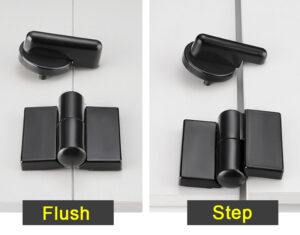In various mechanical and industrial applications, hinges play a crucial role in providing pivotal movement. It’s imperative to understand that the material of the hinge directly affects its performance and durability.
Different materials offer distinct attributes, impacting factors like resistance to wear, corrosion, and overall hinge lifespan. Therefore, selecting the right material for the hinge is instrumental in ensuring its desired functionality and longevity.
Recognizing the key characteristics of these materials can guide manufacturers and users in making informed decisions.

Steel Hinges
Steel, predominantly used in heavy-duty applications, provides unparalleled strength and rigidity. Its high tensile strength ensures that the hinge will be able to withstand substantial force. This strength comes from the unique interlocking of iron and carbon atoms in steel alloys.
However, the carbon content that lends steel its strength also makes it susceptible to rust. To combat this, steel hinges often receive protective coatings or finishes to enhance corrosion resistance. Without these measures or regular lubrication, steel hinges may not deliver on their longevity promises.
Stainless Steel Hinges
Stainless steel hinges, a staple in outdoor or corrosive environments, combine the robustness of steel with enhanced resistance to the elements. The alloying elements, chiefly chromium, play a pivotal role in ensuring that these hinges don’t easily succumb to rust.
By forming a passive layer on the hinge’s surface, stainless steel prevents oxidation. This intrinsic property means that unlike regular steel, stainless steel hinges require significantly less maintenance and upkeep to retain their appearance and function.

Brass Hinges
Brass hinges, with their signature golden hue, hold aesthetic and functional appeal. Their anti-corrosive nature ensures a longer lifespan, especially in environments with moisture. This is a direct result of the zinc and copper blend in brass.
Yet, it’s essential to note that brass’s relatively soft nature doesn’t make it the best fit for heavy-duty applications. While they are resistant to tarnishing, their primary use often leans more towards aesthetic endeavors where appearance is as critical as functionality.
Bronze Hinges
Bronze, an alloy of copper and tin, presents a unique blend of durability and visual charm. Maritime applications often favor bronze because of its exceptional corrosion resistance, a vital trait when in constant contact with salty sea air.
Over time, bronze develops a patina—a greenish layer that can either enhance its aesthetic appeal or be viewed as a drawback, depending on the application’s purpose. This natural aging process can add character to the hinge, making each piece distinct.

Aluminum Hinges
The allure of aluminum hinges lies in their lightweight nature paired with rust resistance. Their popularity in sectors like aerospace stems from the critical balance they strike between weight and strength, maximizing efficiency without compromising on the hinge’s core functionality.
Aluminum’s malleability also means it can be anodized. This process not only improves the hinge’s protection against wear and tear but also augments its visual appeal, presenting a broader palette of finishes and colors.
Plastic Hinges
Certain applications demand minimal weight, excellent corrosion resistance, and electrical insulation—all attributes found in plastic hinges. Their diverse polymer compositions lend them unique characteristics tailored for specific uses.
However, their strength doesn’t match metal counterparts, restricting their application to lightweight doors, panels, and containers. Despite this limitation, their design flexibility and low cost make them a popular choice in many non-heavy-duty scenarios.

Titanium Hinges
Titanium hinges are a testament to the material’s remarkable strength-to-weight ratio. While offering substantial strength, they don’t bring the added weight typical of materials with similar robustness, making them apt for high-demand applications.
Beyond strength, their intrinsic corrosion-resistant and non-magnetic nature finds them a place in medical implants and aerospace applications. Though highly efficient, the cost associated with titanium can sometimes be a barrier to its broader adoption.
Composite Hinges
Composite hinges, constructed from materials like fiberglass and carbon fiber, present a fusion of multiple material benefits. They harness both rigidity and flexibility, catering to niche sectors that require a blend of these traits.
The adaptability of composite materials allows manufacturers to tailor hinges to exact requirements. As technology advances, these hinges are anticipated to see wider adoption, especially in sectors demanding customization.

Zinc Hinges
Zinc, due to its unique properties, can be cast into intricate, precision shapes, making zinc hinges both strong and formable. This ability ensures that zinc hinges can be crafted to meet specific design criteria without compromising on strength.
While inherently strong, zinc is not without its vulnerabilities. Exposed to particular conditions, it can corrode. To combat this, zinc often collaborates with coatings or is alloyed with other metals, enhancing both its functionality and lifespan.
Ceramic Hinges
For applications demanding non-conductivity and resistance to extreme temperatures, ceramic hinges are the answer. Their inherent properties make them invaluable in high-frequency radiation areas or laboratories.
However, their brittleness means they don’t fare well under high impact. They must be used with caution, ensuring the environment is free from scenarios that could lead to sudden shocks or stresses.

Conclusion
The selection of hinge material plays an instrumental role in determining both its performance and lifespan. Whether it’s the unparalleled strength of steel, the high-temperature resilience of ceramics, or the lightweight functionality of aluminum, the material can make or break the hinge’s success in its designated application. It’s vital to consider both the specific needs and environment when making a choice.
You might also be interested:







